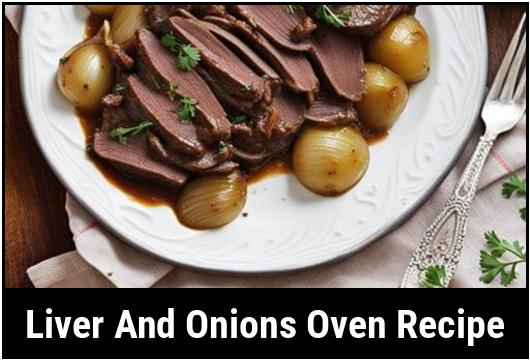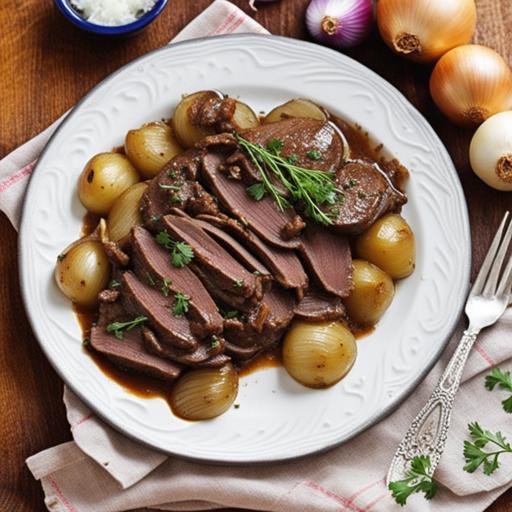
The Ultimate Guide To Cooking Liver And Onions To Perfection
Cooking liver and onions can be a delightful experience if done correctly. The combination of tender liver and caramelized onions creates a dish with a unique flavor profile that is both comforting and satisfying. In this comprehensive guide, we will delve into the food science, culinary details, selection, cleaning, preparation, and various cooking techniques for liver and onions. Get ready to elevate your culinary skills and impress your taste buds with this classic dish.
Understanding the Food Science of Liver and Onions
Before diving into the details of cooking liver and onions, it’s essential to understand the science behind this dish. Liver, particularly beef or calf’s liver, is a highly nutrient-dense organ meat. It is rich in protein, iron, vitamins A and B, and other essential nutrients. The distinct taste of liver can be attributed to its high mineral content and unique composition.
Onions, on the other hand, are a staple ingredient in countless culinary preparations. When cooked, onions release natural sugars that caramelize, enhancing their sweetness and adding depth to the dish. The combination of liver and onions creates a beautiful balance of flavors, with the sweetness of the onions complementing the richness of the liver.
Selecting and Cleaning Liver
When it comes to selecting liver for your recipe, opt for fresh, high-quality liver from a reputable source. The liver should be smooth, firm, and free from any discoloration or unpleasant odor. It’s essential to choose animal livers that are suitable for human consumption, such as beef or calf’s liver, which are commonly used in liver and onions recipes.
Before cooking, it’s crucial to clean the liver thoroughly. Start by rinsing it under cold water, ensuring the entire surface is clean. Trim off any excess fat or membranes to ensure a smoother texture. Pat dry with a paper towel to remove excess moisture.
Preparing the Onions

The caramelization of onions is a crucial step in creating a flavorful base for liver and onions. Here’s a simple yet effective method to prepare the onions:
-
Start by choosing onions that are fresh and firm. Yellow onions are commonly used for this recipe, but you can experiment with other onion varieties as well.
-
Peel the onions and slice them into thin, even slices. Uniformity in size ensures even cooking.
-
Heat a generous amount of butter or oil in a wide skillet over medium heat.
-
Add the sliced onions and sauté them until they turn translucent and start to brown around the edges. This process can take anywhere from 15 to 20 minutes, so be patient and let them slowly caramelize.
-
Stir occasionally to prevent burning and ensure even browning. Lower the heat if necessary.
-
Once the onions have reached a deep golden-brown color, they are ready to be combined with the liver.
Preparation Tips and Techniques
Proper preparation is key to achieving a delicious liver and onions dish. Keep these tips in mind to ensure success:
-
To tenderize the liver and remove any residual bitterness, soak it in milk or buttermilk for at least 30 minutes before cooking. This helps to mellow out the flavor and improve the texture.
-
If desired, you can also marinate the liver in a mixture of vinegar, herbs, and spices for added flavor. This step is optional but can be a tasty addition to your recipe.
-
Prior to cooking, thoroughly pat the liver dry with a paper towel. Excess moisture can prevent proper browning and result in a less desirable texture.
-
For an extra flavor boost, consider dredging the liver in seasoned flour or a mixture of herbs and spices. This will create a delicious crust when cooked.
Cooking Techniques for Liver and Onions

Liver can be a temperamental ingredient to cook. Overcooking can result in a tough, rubbery texture, while undercooking can leave it unpleasantly pink and raw. Let’s explore two popular cooking techniques for liver and onions to ensure perfect doneness:
Stovetop Method
The stovetop method is a traditional way of cooking liver and onions, yielding tender, flavorful results. Here’s how to master this technique:
-
In a skillet or a sauté pan, melt a generous amount of butter or heat oil over medium heat.
-
Once the fat is heated, add the liver slices to the pan, ensuring they do not overlap. Crowding the pan can lead to uneven cooking.
-
Sear the liver for a few minutes on each side until golden brown, without moving them too often. This will help to develop a delicious crust on the surface.
-
Use your judgment and cooking experience to determine the desired level of doneness. Liver is often cooked to medium or medium-well to retain its tenderness while ensuring it is thoroughly cooked.
-
Once the liver is cooked to your liking, transfer it to a plate, cover it loosely with foil, and allow it to rest for a few minutes. This helps redistribute the juices and ensures optimal flavor.
-
Serve the liver slices on a bed of caramelized onions, and garnish with fresh herbs if desired. This classic combination is sure to impress your taste buds.
Oven Method
Alternatively, you can also achieve wonderful results by cooking liver and onions in the oven. This method allows for even cooking and simplifies the process. Follow these steps for a delightful oven-baked liver and onions:
-
Preheat your oven to 400°F (200°C).
-
In an oven-safe skillet or baking dish, arrange the liver slices in a single layer. Ensure they have some space between them for even cooking.
-
Add the caramelized onions on top of the liver, evenly distributing them.
-
Place the skillet or baking dish in the preheated oven and cook for approximately 10-15 minutes. Cooking time may vary depending on the thickness of the liver slices and desired level of doneness.
-
To check for doneness, use a meat thermometer to ensure the internal temperature of the liver reaches 160°F (71°C). This ensures the liver is thoroughly cooked and safe to eat.
-
Once cooked, remove from the oven and let the dish rest for a few minutes before serving. The remaining heat will continue to cook the liver slightly, so consider this while checking for doneness.
Variations and Flavor Enhancements
While the classic liver and onions recipe is delicious on its own, you can experiment with various flavor enhancements and ingredient substitutions to suit your taste preferences. Here are a few ideas to inspire your creativity:
-
Incorporating Herbs: Add fresh or dried herbs to the onions while they caramelize for an extra layer of flavor. Sage, thyme, rosemary, or parsley work particularly well with liver and onions.
-
Sauce Accompaniments: Pair your liver and onions with a flavorful sauce such as mushroom gravy, balsamic reduction, or a tangy mustard sauce. These sauces complement the richness of the dish and add depth to the flavor profile.
-
Adding Bacon: For those who can’t resist the smoky goodness of bacon, consider including crispy bacon bits in your liver and onions recipe. The savory notes of bacon complement the sweetness of the onions and add a delightful crunch.
-
Substituting Onions: If you’re not a fan of onions or want to experiment with alternative flavors, consider using shallots, leeks, or even caramelized apples. These ingredients offer a unique twist to the classic dish.
Doneness Checks and Safety Precautions
When preparing liver and onions, it is crucial to ensure safe internal temperatures and optimal doneness. Remember these key points:
-
Liver should be cooked until it reaches an internal temperature of 160°F (71°C) to ensure safety and eliminate any potential risks associated with undercooked meat.
-
Using a meat thermometer is the most reliable way to check for doneness. Insert the thermometer probe into the thickest part of the liver to get an accurate reading.
-
Overcooking liver can result in a tough texture. It’s important to find the balance between achieving doneness and preserving the tenderness of the meat.
Conclusion
Liver and onions are a classic dish that deserves recognition for its unique flavors and nutritional value. With the information provided in this comprehensive guide, you are now equipped with the knowledge and techniques needed to create a mouthwatering liver and onions meal. From understanding the food science behind the dish to selecting the right liver, preparing the onions, and trying out different cooking techniques, you have all the tools you need to impress your family and friends with this flavorful culinary creation. Dive into the world of liver and onions, and let your taste buds soar!
Sources
FAQS On Liver And Onions Oven Recipe
What Ingredients Do I Need For A Liver And Onions Oven Recipe?
To prepare a delicious liver and onions dish in the oven, you will need sliced liver, onions, flour, salt, pepper, olive oil, and beef broth.
How Do I Properly Prepare The Liver And Onions For The Oven?
Start by dredging the liver slices in flour mixed with salt and pepper. Then, heat some olive oil in a skillet and brown the liver on both sides. Remove the liver and sauté the onions in the same skillet until they are caramelized.
What Is The Best Way To Cook Liver And Onions In The Oven?
After browning the liver and sautéing the onions, place them in a baking dish and pour beef broth over them. Cover the dish with foil and bake in the oven at 350°F for about 30 minutes, or until the liver is cooked through.
How Can I Ensure The Liver Is Not Overcooked In The Oven?
Liver can become tough and dry if overcooked. To prevent this, use a meat thermometer to check the internal temperature of the liver. Once it reaches 160°F, it is done and should be removed from the oven.
What Is The Recommended Way To Serve Liver And Onions Cooked In The Oven?
Once the liver and onions are cooked, you can serve them with mashed potatoes and a side of vegetables, or over a bed of rice. The flavorful gravy created during the baking process can be spooned over the liver and onions for added richness.



